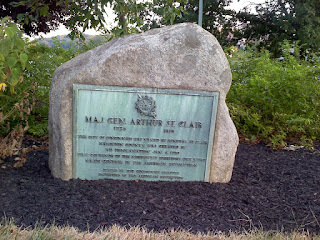 March 1st is Ohio Statehood Day when Ohio became the 17th state in 1803. Happy 210th!
March 1st is Ohio Statehood Day when Ohio became the 17th state in 1803. Happy 210th!Or did Ohio become a state February 19th, 1803?
Maybe it was it August 7th...1953?
 |
| at a crossroad |
St. Clair proposed new state boundaries for the territory that essentially divided it in two and would prevent Ohio from becoming a state at that time since it did not meet the population criteria for statehood.
 |
| the man who busted Arthur |
Jefferson was, of course, was eager to add Ohio as the 17th US State to increase his party's control. So, the 7th US Congress rejected St. Clair's plan and in April 1802 passed the Enabling Act which put Ohio on the fast track to becoming a state by new rules that favored the Democratic-Republican Party.
When Ohio's new Constitutional Convention met in Chillicothe St. Clair angrily denounced the Enabling Act. Word got back to Jefferson and the President promptly fired Art and appointed Charles William Byrd as Governor. You can probably guess that the new guy was also a Democratic-Republican.
 |
| all St. Clair got was a rock |
The only thing is, there was a problem. In 1953 (yes nineteen) it was discovered that due to a technicality, Congress did not formally declare Ohio a US State. Eventually, that was resolved and they backdated statehood to March 1st, 1803. More on that here.
What happened to St. Clair? He rode off into the sunset with his gout. It turned out he had loaned much of his fortune to the cash-strapped US government while serving as Governor for 14 years and Congress never paid him back. As a result of all this, one of America's original military and political leaders, a once powerful man, died disgraced, penniless and forgotten in 1818 at his home in PA.
Isn't politics fun?
Hi great readinng your post
ReplyDelete